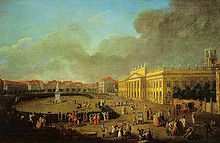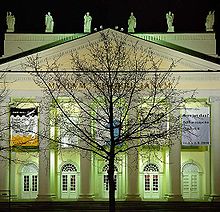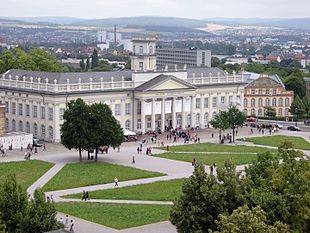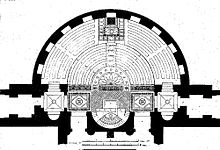Fridericianum (Kassel)
The Fridericianum is a museum building in Kassel . The building, completed in 1779, served from the beginning as one of the first public museums on the European continent for the art objects collected by the Hessian landgraves and housed the princely library. In the Kingdom of Westphalia , the Fridericianum 1810-1813 was Stands palace with Parliament hall. Today the Fridericianum becomes the focus of the documenta every five years and is an exhibition space for contemporary art, the “Kunsthalle Fridericianum”. The building is on Friedrichsplatz between the former old town and Oberneustadt .
Conception
After the Seven Years' War , the old ramparts of the city of Kassel was superfluous and that began under Landgrave Friedrich II. In 1768 with the demolition . On the vacated area between the old town and the Oberneustadt, Friedrichsplatz was laid out as an urban connecting link. On its main page, the construction of the museum began in 1769 in order to enable the Landgraves' art collections to be displayed publicly in the interests of the Enlightenment . Even if the Fridericianum is not the first public museum , it is considered to be the first building to be designed as a museum from the start.
architecture
The Fridericianum was built from 1769 to 1779 under the direction of the architect Simon Louis du Ry . A counter-concept drawn up by Claude-Nicolas Ledoux during the construction period was not implemented. In addition to the Wörlitz Castle (1769–1773), the Fridericianum is the first purely classical building in Germany. The construction work dragged on for ten years because the difficult subsoil and the steep incline led to delays. The 1330 built Zwehrenturm , part of the medieval fortification of Kassel and temporarily Observatory , was rebuilt according to the plans you Rys and connected to the Fridericianum. In the Westphalian era, the building underwent some renovations.
Exterior

The Fridericianum forms a symmetrical three-wing complex. The front building on the front of the square is almost 80 meters long and is structured by 19 axes. The front is characterized by a portico supported by six Ionic columns . The entire facade is structured by Ionic pilasters . The 41-meter-long flanks adjoining at the rear surround a small courtyard with the former staircase. The attic behind the portico is crowned by six allegorical statues depicting philosophy, astronomy, history, architecture, painting and sculpture. The building was badly damaged in World War II , but the exterior was restored. The shape of the roof has been raised somewhat inconveniently.
Interior
Originally the building only had two floors. On the ground floor, two large halls for the collections extended on either side of the vestibule . The upper floor housed the library in a hall that took up the entire length of the building and had a gallery around it. In the side wing there were various smaller collection and work rooms. The building burned down in the Second World War and was later completely gutted and rebuilt with three storeys.
history
collection
museum
Even under Landgrave Moritz, there was a separate cabinet of curiosities in the newly built stables during the Renaissance . With the growth of the collection and the ever-growing court library, new collection rooms became necessary. The new museum housed the landgrave's art collections. A description of the collections is passed down in a letter from Hector Wilhelm von Günderrode from 1781. The collection of antiquities started by Landgrave Friedrich II , including the Kassel Apollo, was on the ground floor . The natural history collection now housed in the Ottoneum with the stuffed elephant from the menagerie also found its place here. There was also an extensive collection of cork models of ancient buildings. In addition to the extensive library, the weapons collection and wax figures of historic Hessian landgraves were located on the upper floor . The Zwehrenturm got a new observatory room with the octagonal tower and housed the astronomical-physical collection. Most of the exhibits are now in the holdings of the Hessen Kassel Museum Landscape (mhk). The natural history objects were relocated as early as 1888, and the remaining holdings were transferred to the newly built Hessisches Landesmuseum Kassel in 1913 . Since then and until the Second World War, the house was used as a state library .
Library
The Hessian State Library was founded in 1580 by Landgrave Wilhelm IV . Under Friedrich II of Hessen-Kassel , the library was reorganized by Jean-Louis Barbot de Luchet and then moved to the Fridericianum. It was there until the Second World War. Jacob and Wilhelm Grimm both found employment in the library during their time in Kassel. Jacob Grimm was the private librarian of the Westphalian King Jérôme Bonaparte from 1808 to 1814 through Johannes von Müller , his brother was secretary in the library from 1816 to 1829. Here they worked on their work on “German Grammar” and laid the foundation for German studies .
After the library was expanded to include the entire building in 1913, the books remained in the Fridericianum during World War II and were almost completely burned there in a bomb attack in September 1941. Around 350,000 volumes were lost. The rescued copies are now in the holdings of the Kassel University Library, such as the Hildebrandslied .
Estates Palace
During the time of the Kingdom of Westphalia , the Fridericianum was converted into the “Palace of Estates” in 1810 by Napoleon's brother Jérôme Bonaparte and his architect Auguste Henri Victor Grandjean de Montigny . Therefore it is also the first German parliament building .
Museum of Modernism

After being severely damaged in World War II and being rebuilt, the Fridericianum is now an exhibition building again. Owned by the State of Hesse, the building is managed by documenta und Museum Fridericianum gGmbH and used for temporary exhibitions at the Fridericianum and documenta .
documenta
Since the first documenta in 1955, the Fridericanum has been the focus of every subsequent documenta. The damaged building was poorly but functionally restored under Arnold Bode . The first documenta was initially limited to this building. As the exhibition grew, the exhibition areas were spread across other buildings and open spaces in the city. Against the background of the Starfighter affair , Wolf Vostell wanted to put a Starfighter on the roof of the Fridericianum for documenta 6 , which he was not allowed to do.
Art gallery Fridericianum
Since 1988 the Fridericianum has presented continuously changing exhibitions of contemporary art. Solo exhibitions of young international artists are shown, which often emphasize spatial aspects. In some cases, retrospectives are also part of the program. In terms of content, the focus is on contemporary and socially critical statements by artists.
After Rein Wolf's appointment as the new director of the Art and Exhibition Hall of the Federal Republic of Germany in Bonn, the board of directors of documenta und Museum Fridericianum gGmbH elected the curator Susanne Pfeffer as the new artistic director.
Directors and exhibitions
Veit Loers opened the Fridericianum as an exhibition space for contemporary art with the group exhibition Sleep of Reason (1988). Loers u. a. Pierre Soulages (1989), Paul Klee (1989), Günther Förg (1990), Cady Noland and Félix González-Torres ( In the Sign of Violence , 1991), László Moholy-Nagy (1991), Franz West (1994) and Tobias Rehberger (1995).
In 1998 René Block took over the management. In addition to exhibitions on the Fluxus movement, he presented thematic exhibitions and large-scale group exhibitions such as In den Schluchten des Balkans (2003). With the exhibition format Rundgang , Block gave the next generation of artists at European academies a stage. Solo exhibitions were u. a. Joan Brossa (1998), Robert Watts (1999), Sophie Calle (2000), Richard Hamilton (2000), Rolf Julius (2001), Christian Marclay (2003), Jalal Toufic (2006), Marina Abramovic (2006) and Yael Bartana (2006) dedicated.
Block's successor Rein Wolf ran the Fridericianum from 2008 to 2013. Wolfs showed solo exhibitions by young, international contemporary artists such as Christoph Büchel (2008), Klara Lidén (2009), Cyprien Gaillard (2009), Rirkrit Tiravanija (2009), Meschac Gaba (2009 ), Thomas Zipp (2010), Monica Bonvicini (2010), Teresa Margolles (2011) and Danh Vo (2011).
From June 2013 to the end of 2017, the curator Susanne Pfeffer was director of the Fridericianum. Conceived as a trilogy, she presented the group exhibitions Speculations on Anonymous Materials (2013), nature after nature (2014) and Inhuman (2015). She also dedicated the world's first comprehensive retrospective to the American experimental filmmaker Paul Sharits . Another solo presentation showed works by the British artist Helen Marten . In 2015, Pfeffer showed works by the Belgian artist Marcel Broodthaers in a large retrospective . In 2016 she showed a solo exhibition by Korean Anicka Yi.
On November 1, 2018, the former director of the Kölnischer Kunstverein, Moritz Wesseler, took over as director.
Kassel Art Association
The 1835 u. a. Kunstverein für Kurhessen (cooperative) founded by Ludwig Emil Grimm is one of the oldest civil art associations in Germany. In 1868 the association, together with two other art associations based in Kassel, built a house for painting exhibitions and for social artistic purposes. The city made the building site available free of charge and organized a design competition. From the seven drafts received, a committee selected the architect Scholtz's proposals for implementation, which began in 1869. The construction costs were around 20,000 marks. The exterior of the building was decorated with groups of figures: on the attic the allegories for music, poetry and history, caryatids at the main entrance and nine medallion portraits directly on the facade. The sculptures and medallions partly made of sandstone, partly made of ceramic, come from the workshop of the sculptor Hassenpflug and the artist O. Müller from Berlin.
During the documenta-free time, the association has been using a 500 m² exhibition area on the ground floor since 1993. Mainly young contemporary artists are presented here. The chairman of the art association has been Joel Baumann , Rector of the Kassel Art College since 2013 . During the expansion and provision of the rooms for the times of the art exhibition, external rooms, the KasselerKunstVereinsheim, were rented in 2007 and 2012 and offered as a place of mediation for various projects.
literature
- Dehio Handbook Hessen. Deutscher Kunstverlag, Munich 1982, p. 480 f.
- Cornelius Steckner: Ledoux, Kassel and the American War of Independence. In: XXVIIe Congrès International d'Histoire de l'Art. L'Art et les Revolutions. Strasbourg 1992, pp. 345-372. (with images of Ledoux's personal corrections to the Fridericianum)
- Alois Holtmeyer: The architectural and art monuments in the Kassel administrative region. Volume VI. Marburg an der Lahn 1923.
- Andrea Linnebach: The Museum of Enlightenment and its audience. Kunsthaus and Museum Fridericianum in Kassel in the context of the historical visitor book (1769–1796). Kassel 2014.
- Maximiliane Mohl: The Museum Fridericianum in Kassel: Museum architecture, collection presentation and educational program in the Age of Enlightenment . Heidelberg 2020.
- Literature by and about “Fridericianum in Kassel” in the catalog of the German National Library
Web links
- Official website of the Kunsthalle Fridericianum
- Museum Fridericianum . In: Kassel.de
- The Fridericianum Museum (1769–79) . In: Museumgeschichte.Uni-Kassel.de
- Database for the historical visitor book of the Museum Fridericianum . In: UB.Uni-Kassel.de
- Search for Fridericianum in Kassel in the German Digital Library
- Publication by and about the Fridericianum in Kassel in the SPK digital portal of the Prussian Cultural Heritage Foundation
Individual evidence
- ^ Friedrich Wilhelm Strieder: De Luchet (Jean Pierre Louis) . In: Friedrich Wilhelm Strieder (Ed.): Basis for a Hessian history of scholars and writers . tape 8 : Leu - Meur. Cramer, Barmeier, Kassel / Göttingen 1788, p. 415 ff .
- ↑ Wilhelm Scherer: Grimm, Jakob . In: Allgemeine Deutsche Biographie . tape 9 : Geringswald - Gruber. Duncker & Humblot, Leipzig 1879, p. 679 ( deutsche-biographie.de ).
- ^ Friedrich Neumann: Grimm, Wilhelm . In: Otto zu Stolberg-Wernigerode (Hrsg.): New German biography . tape 7 : Grassauer - Hartmann. Duncker & Humblot, Berlin 1966, p. 77 ( deutsche-biographie.de ).
- ^ Klaus Garber : The Gomorrah of the German libraries . In: Frankfurter Allgemeine Zeitung of May 13, 2015, p. N3.
- ↑ Wolf Vostell documenta 6
- ↑ City of Kassel documenta-Stadt updates: The supervisory board of the documenta und Museum Fridericianum Veranstaltungs-GmbH announces personnel decisions ( memento from April 22, 2014 in the Internet Archive ), accessed on April 15, 2013.
- ↑ http://dirkschwarze.net
- ^ Archive website Fridericianum
- ↑ http://archiv2.fridericianum-kassel.de/ausstellungen
- ↑ http://www.fridericianum.org
- ↑ monopol Magazin für Kunst und Leben from September 7, 2018: Kassel: Moritz Wesseler becomes director of the Fridericianum accessed on September 8, 2018
- ^ The art club house in Cassel . In: Zeitschrift für Bauwesen (26) 1876; VIII-X; Pp. 343/344; accessed on April 23, 2015.
Coordinates: 51 ° 18 ′ 49 ″ N , 9 ° 29 ′ 51 ″ E




